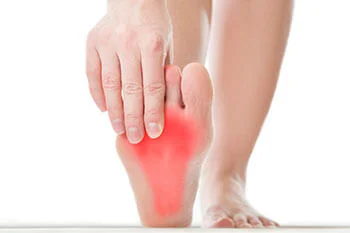Table of Contents
Plantar Fasciitis - Overview
Plantar fasciitis is an inflammation of the plantar fascia – the thick band of tissue that runs from the heel to the toes. This is a common condition that affects millions of people each year, and it’s most common symptom is heel pain. Plantar fasciitis can take a long time to heel as the foot is subject to a lot of stress and impact every day.
As chronic inflammation of the plantar fascia can also cause bone spurs, it’s important to regularly see a board-certified podiatrist. Our podiatrists at University Foot & Ankle Institute can help accurately diagnose the cause of your heel pain and develop a personalized treatment plan for you.
Plantar Fasciitis - Symptoms
There are several symptoms of plantar fasciitis, the most common being stabbing pain near the bottom of the heel. Other symptoms can include:
- Pain along the heel or sole of your foot
- Redness
- Mild swelling
- Tightness along the bottom of your foot or Achilles tendon
- Pain is worse in the morning
If you are experiencing any of the above symptoms, it’s important to make an appointment with a board-certified podiatrist. Heel pain is a symptom of plantar fasciitis but also of tendonitis, nerve pain, stress fractures, cysts, and arthritis. One of our doctors can accurately diagnose your foot issue or heel pain, so we can personalize the best treatment plan for you.
Plantar Fasciitis - Causes
Many different things can cause plantar fasciitis, such as an injury or lifestyle habits. Various causes include:
- An injury: Any injury affecting the foot – especially a ligament injury – can impact the plantar fascia and cause plantar fasciitis.
- Shape of your foot: Those with flat feet or high arches are more susceptible to suffering from plantar fasciitis. In both these shapes, the plantar fascia ligament is under more pressure.
- Overuse: Those who are continually active on their feet by walking, running, or standing are routinely applying pressure to their plantar fascia. This can create problems from chronic overuse, such as plantar fasciitis.
- Unsupportive shoes: Wearing shoes without adequate support or wearing high heels frequently can cause a lot of strain on the sole of your foot, which overtime can lead to plantar fasciitis.
- Weight gain: As plantar fasciitis is caused by stress and strain on the plantar fascia ligament, any extra weight gain can put pressure on the ligament.
Seeing a podiatrist regularly can help you monitor any changes in your lifestyle or feet, so if issues do arise, they are easier to detect.
Plantar Fasciitis - Treatment
With plantar fasciitis, the best treatment comes from a combination of podiatric care and lifestyle changes. From a medical perspective, treatment options include:
- Physical therapy
- Custom orthotics
- Medication for pain relief
- Shockwave therapy
- Steroid injections
- Surgery, if severe
From a lifestyle perspective, the following can help relieve the pain of plantar fasciitis:
- Icing
- Stretching before and after every activity
- Taking time to rest your feet after high-impact activities
- Always wearing supportive shoes or sandals, even at home
One of the best physical therapy exercises to relieve pain from plantar fasciitis is rolling a ball, foam roller, or water bottle under your foot.
Conclusion
Plantar Fasciitis FAQs
What are the symptoms of plantar fasciitis?
What are the treatment options for plantar fasciitis?
What causes plantar fasciitis?
What Should You Do Next?
You don’t have to suffer from plantar fasciitis. Call our experienced team at the nearest location or schedule an appointment online today.
Looking to schedule an appointment with a physician?
Call us today or book an appointment online today for effective solutions to your painful hammertoes.




